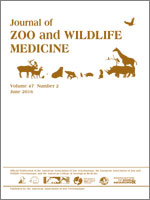ϵ-Aminocaproic acid (EACA) is a lysine analogue antifibrinolytic drug used to treat bleeding disorders in humans and domestic animals. Use in zoological medicine is rare and dose recommendations are anecdotal, but EACA may be a valuable therapeutic option for bleeding disorders in exotic species, including Asian elephants (Elephas maximus). This study used an in vitro model of hyperfibrinolysis and a thromboelastograph-based assay to estimate the therapeutic plasma concentration of EACA in Asian elephants (61.5 μg/ml, 95% CI = 34.6–88.5 μg/ml). Substantial but incomplete inhibition of lysis was seen at relatively low concentrations of EACA (40 μg/ml). Asian elephants appear sensitive to EACA-mediated inhibition of hyperfibrinolysis. Doses published for domestic animals, targeting higher plasma concentrations, may be inappropriate in this species.
How to translate text using browser tools
1 June 2016
EFFECT OF ϵ-AMINOCAPROIC ACID ON FIBRINOLYSIS IN PLASMA OF ASIAN ELEPHANTS (ELEPHAS MAXIMUS)
Sarrah Kaye,
Noha Abou-Madi,
Daniel J. Fletcher
ACCESS THE FULL ARTICLE
ϵ-aminocaproic acid
Asian elephant
Elephas maximus
fibrinolysis
thromboelastography





